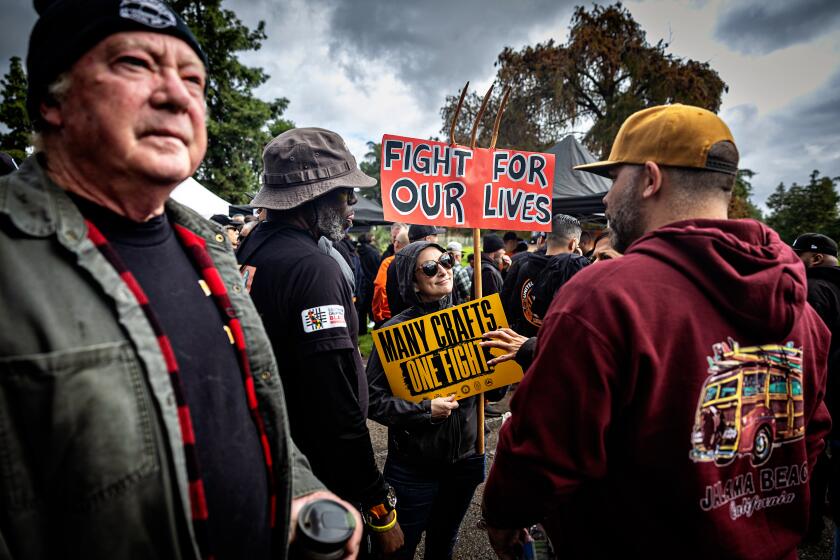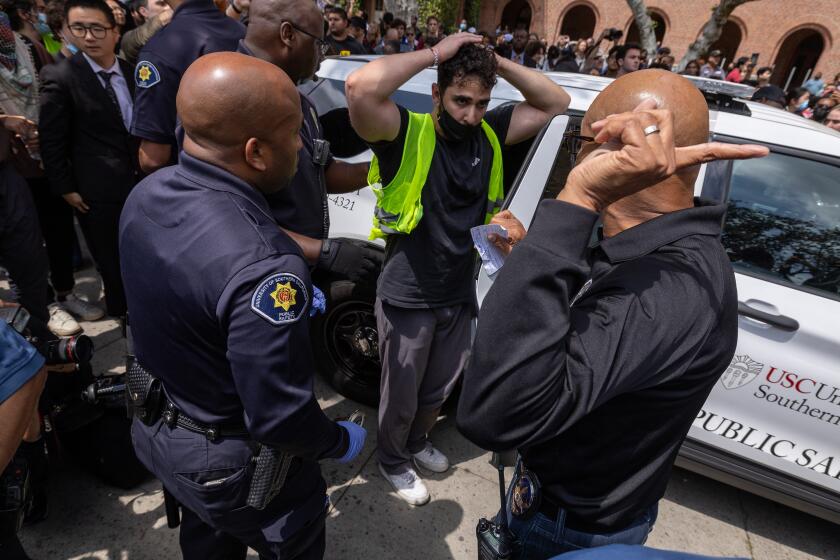A ‘living library’ that opens minds
On Oct. 18, the Santa Monica Public Library hosted an unusual interactive event called “The Living Library,” in which people were the books and could be checked out for half an hour’s conversation. Borrowers were instructed that “the Reader must return the Book in the same mental and physical condition as borrowed. It is forbidden to cause damage to the book, tear out or bend pages, get food or drink spilled over the book or hurt her or his dignity in any other way.”
When I suggested to my 10-year-old son, Luke, and his pal, Grace, that it might be cool to go check out a book-person, they were dubious. They’re good readers and completely comfortable at the big library, but that’s because they know what will happen there and what is expected of them. They had a lot of questions about living books. Could they take out a book together? What exactly were they supposed to do with them? Would the books tell them stories?
None of us knew the answers, so we presented ourselves together in the peaceful courtyard of the downtown Santa Monica Main Library on Saturday afternoon: Luke, Grace, Grace’s mother, Liz Dubelman, and I.
The first hurdle was the choice of book; the kids had quickly decided to take out a book together. The list offered at the Living Library desk included a Buddhist, a nudist, a raw foodist and many other specialties that didn’t necessarily rhyme, such as a fat activist, a feminist, a Oaxacan American and a celebrity publicist. The children briefly considered taking out a formerly homeless person, because they always have questions for their parents about how people actually manage on the streets. However, they rejected that notion as too embarrassing.
They settled on a teenager, then two teenagers, since the desk told them two teenagers were available. One went to public school, one to private school. That’s all we knew about them. They would be available for check-out in 45 minutes.
Having decided to treat their half-hour as an interview, the kids repaired to a study room to draw up questions, emerging half an hour later with a list of queries that was a snapshot of contemporary American childhood: How much time do you spend doing homework? What do you do on Halloween? How much do you care about your hair? What embarrassing moments have you had, and how do you deal with them? How much time do you spend online and texting your friends? Have you traveled? What’s your favorite food? How do you feel about coffee and cigarettes? Piercings? Tattoos?
“The Living Library” idea originated in 2000 in Denmark, the creation of anti-violence activist Ronni Abergel, as a way to overcome prejudices, bring people face to face with others they wouldn’t encounter in daily life and encourage dialogue that might dispel misconceptions. The program has been repeated in many countries, and the “bestseller” -- the most highly sought-after book -- has often been a politically charged character. At the first Living Library in Denmark, one of the hits was a young Arabic Muslim; in Hungary, a former right-wing extremist.
Santa Monica’s event represented the first time the Living Library had come to the United States. Rachel Foyt, the library official who brought the project to Santa Monica after reading about it in the Guardian, said that their event emphasized “issues on the minds of Santa Monicans” and drew a sell-out crowd of more than 100 readers in the course of the day. Finding people to act as books was sometimes a tricky issue, said Foyt: “Some books were hesitant. The nudist and the formerly homeless woman were nervous about type of questions they would get. But they said it was a rewarding experience, and the questions were respectful.”
In celebration of the theme of overcoming prejudice, the library was giving away T-shirts to participants that read: “Don’t judge a book by its cover,” and that turned out to be an excellent theme for our kids’ experience. Luke was clearly expecting his idea of teenagers: 14-year-old male skateboarders (or snowboarders; he wasn’t too narrow). Instead, the teenagers in question turned out to be two relatively bookish 17-year-old girls, Desiree Johnson and Lupita Lerma, both involved in the library’s Teen Council. Luke was, needless to say, taken aback, and immediately began mentally scrapping certain of his questions, notably the ones dealing with certain video games and Tech Decks (trust me, if you need to ask, you don’t want to know).
Luke and Grace had each arranged for the mothers to ask a touchy question, Grace about when it’s OK to have sex, and Luke about their attitude toward people of other races, and whether race was an issue at school. As the kids sat down with the teens, they made it clear with a look in our direction that when the time came, it would be the mothers asking these difficult questions. However, there is something about a formal setting that can ease conversation. Dinner parties are best when you’ve invited people who are interested in each other but not too familiar with each other. Formal situations put people on their best behavior.
The children consulted their list of questions and got under way with easy ones: How old are you? Where do you go to school? Pretty soon, everything was rolling along just fine. Questions were asked, stories were told, there was laughing. In answer to a question about her most embarrassing experience, Lupita told a story about learning to ski (or not), and everyone jumped in with a story. The kids found that at the end of half an hour, they could respectfully ask even the difficult questions and get thoughtful answers.
Grace wrote in an essay about the event later that Desiree and Lupita were “truly open books. When they were asked about zits, no problem. They answered that they were embarrassing and hard to get rid of. They didn’t so much as blush.” She described the Living Library as a place “where you have a half-hour conversation with someone you wouldn’t normally hang out with. . . . I would go again and again to talk to new people. It’s important to know about other jobs and lifestyles. They may seem strange to you, but it’s important to see things from another perspective.”
And isn’t expanding the mind what libraries are all about?
For more information, visit the Living Library’s website:
The Santa Monica Public Library is considering hosting another Living Library in April, during National Library Week. Upcoming events can be checked on their website:
Sonja Bolle’s Word Play column appears monthly at www.latimes.com/books.
More to Read
The biggest entertainment stories
Get our big stories about Hollywood, film, television, music, arts, culture and more right in your inbox as soon as they publish.
You may occasionally receive promotional content from the Los Angeles Times.






